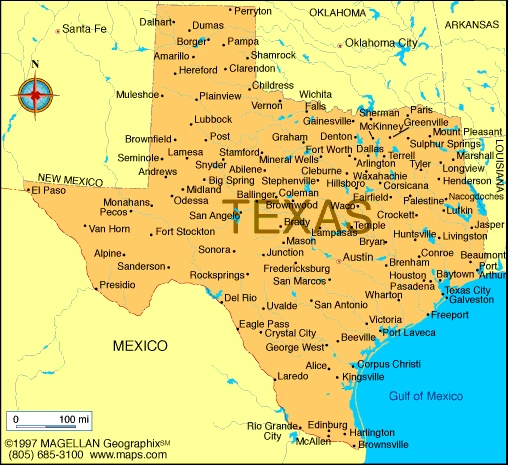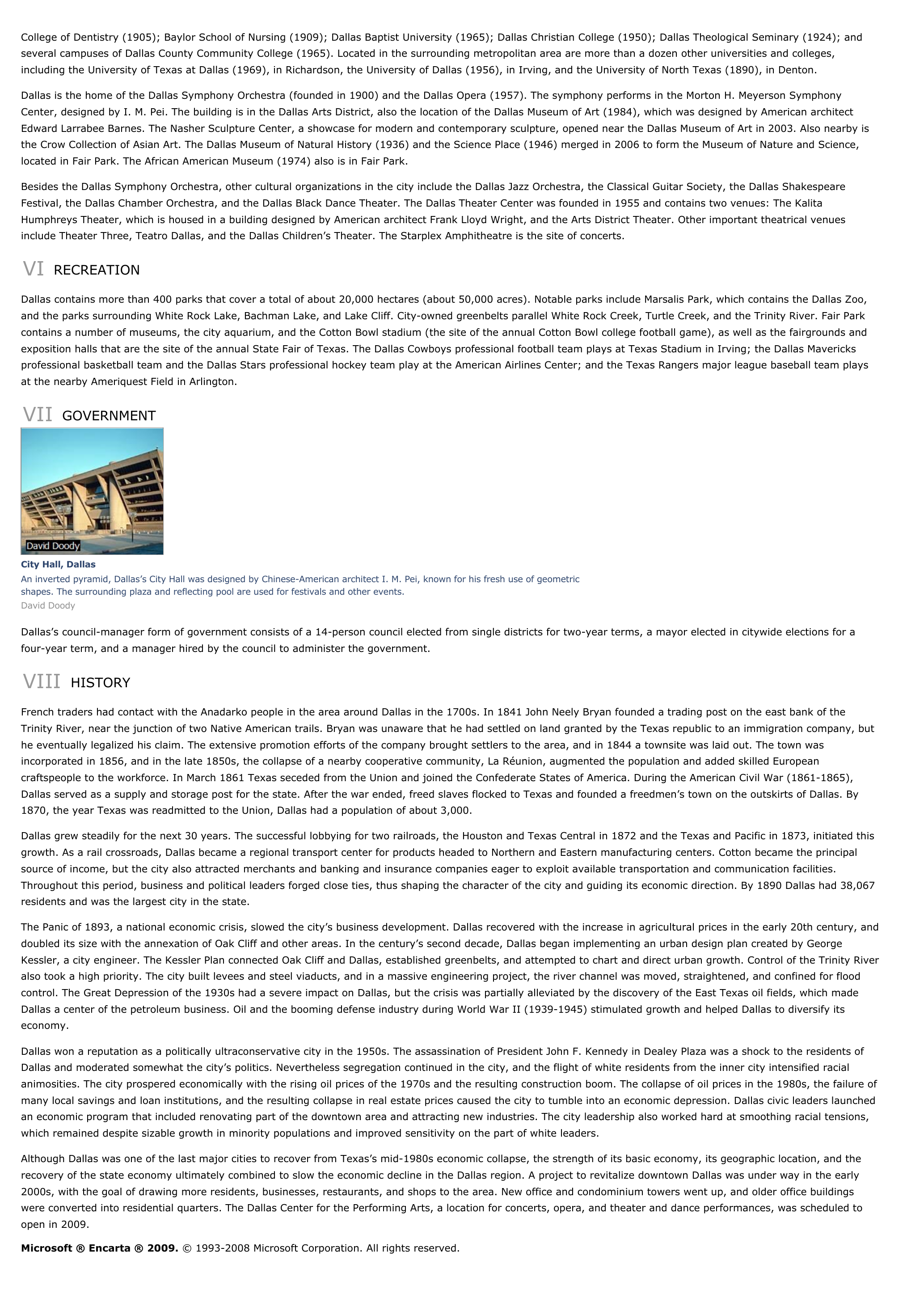Dallas (Texas) - geography.
Publié le 27/05/2013

Extrait du document


«
College of Dentistry (1905); Baylor School of Nursing (1909); Dallas Baptist University (1965); Dallas Christian College (1950); Dallas Theological Seminary (1924); andseveral campuses of Dallas County Community College (1965).
Located in the surrounding metropolitan area are more than a dozen other universities and colleges,including the University of Texas at Dallas (1969), in Richardson, the University of Dallas (1956), in Irving, and the University of North Texas (1890), in Denton.
Dallas is the home of the Dallas Symphony Orchestra (founded in 1900) and the Dallas Opera (1957).
The symphony performs in the Morton H.
Meyerson SymphonyCenter, designed by I.
M.
Pei.
The building is in the Dallas Arts District, also the location of the Dallas Museum of Art (1984), which was designed by American architectEdward Larrabee Barnes.
The Nasher Sculpture Center, a showcase for modern and contemporary sculpture, opened near the Dallas Museum of Art in 2003.
Also nearby isthe Crow Collection of Asian Art.
The Dallas Museum of Natural History (1936) and the Science Place (1946) merged in 2006 to form the Museum of Nature and Science,located in Fair Park.
The African American Museum (1974) also is in Fair Park.
Besides the Dallas Symphony Orchestra, other cultural organizations in the city include the Dallas Jazz Orchestra, the Classical Guitar Society, the Dallas ShakespeareFestival, the Dallas Chamber Orchestra, and the Dallas Black Dance Theater.
The Dallas Theater Center was founded in 1955 and contains two venues: The KalitaHumphreys Theater, which is housed in a building designed by American architect Frank Lloyd Wright, and the Arts District Theater.
Other important theatrical venuesinclude Theater Three, Teatro Dallas, and the Dallas Children’s Theater.
The Starplex Amphitheatre is the site of concerts.
VI RECREATION
Dallas contains more than 400 parks that cover a total of about 20,000 hectares (about 50,000 acres).
Notable parks include Marsalis Park, which contains the Dallas Zoo,and the parks surrounding White Rock Lake, Bachman Lake, and Lake Cliff.
City-owned greenbelts parallel White Rock Creek, Turtle Creek, and the Trinity River.
Fair Parkcontains a number of museums, the city aquarium, and the Cotton Bowl stadium (the site of the annual Cotton Bowl college football game), as well as the fairgrounds andexposition halls that are the site of the annual State Fair of Texas.
The Dallas Cowboys professional football team plays at Texas Stadium in Irving; the Dallas Mavericksprofessional basketball team and the Dallas Stars professional hockey team play at the American Airlines Center; and the Texas Rangers major league baseball team playsat the nearby Ameriquest Field in Arlington.
VII GOVERNMENT
City Hall, DallasAn inverted pyramid, Dallas’s City Hall was designed by Chinese-American architect I.
M.
Pei, known for his fresh use of geometricshapes.
The surrounding plaza and reflecting pool are used for festivals and other events.David Doody
Dallas’s council-manager form of government consists of a 14-person council elected from single districts for two-year terms, a mayor elected in citywide elections for afour-year term, and a manager hired by the council to administer the government.
VIII HISTORY
French traders had contact with the Anadarko people in the area around Dallas in the 1700s.
In 1841 John Neely Bryan founded a trading post on the east bank of theTrinity River, near the junction of two Native American trails.
Bryan was unaware that he had settled on land granted by the Texas republic to an immigration company, buthe eventually legalized his claim.
The extensive promotion efforts of the company brought settlers to the area, and in 1844 a townsite was laid out.
The town wasincorporated in 1856, and in the late 1850s, the collapse of a nearby cooperative community, La Réunion, augmented the population and added skilled Europeancraftspeople to the workforce.
In March 1861 Texas seceded from the Union and joined the Confederate States of America.
During the American Civil War (1861-1865),Dallas served as a supply and storage post for the state.
After the war ended, freed slaves flocked to Texas and founded a freedmen’s town on the outskirts of Dallas.
By1870, the year Texas was readmitted to the Union, Dallas had a population of about 3,000.
Dallas grew steadily for the next 30 years.
The successful lobbying for two railroads, the Houston and Texas Central in 1872 and the Texas and Pacific in 1873, initiated thisgrowth.
As a rail crossroads, Dallas became a regional transport center for products headed to Northern and Eastern manufacturing centers.
Cotton became the principalsource of income, but the city also attracted merchants and banking and insurance companies eager to exploit available transportation and communication facilities.Throughout this period, business and political leaders forged close ties, thus shaping the character of the city and guiding its economic direction.
By 1890 Dallas had 38,067residents and was the largest city in the state.
The Panic of 1893, a national economic crisis, slowed the city’s business development.
Dallas recovered with the increase in agricultural prices in the early 20th century, anddoubled its size with the annexation of Oak Cliff and other areas.
In the century’s second decade, Dallas began implementing an urban design plan created by GeorgeKessler, a city engineer.
The Kessler Plan connected Oak Cliff and Dallas, established greenbelts, and attempted to chart and direct urban growth.
Control of the Trinity Riveralso took a high priority.
The city built levees and steel viaducts, and in a massive engineering project, the river channel was moved, straightened, and confined for floodcontrol.
The Great Depression of the 1930s had a severe impact on Dallas, but the crisis was partially alleviated by the discovery of the East Texas oil fields, which madeDallas a center of the petroleum business.
Oil and the booming defense industry during World War II (1939-1945) stimulated growth and helped Dallas to diversify itseconomy.
Dallas won a reputation as a politically ultraconservative city in the 1950s.
The assassination of President John F.
Kennedy in Dealey Plaza was a shock to the residents ofDallas and moderated somewhat the city’s politics.
Nevertheless segregation continued in the city, and the flight of white residents from the inner city intensified racialanimosities.
The city prospered economically with the rising oil prices of the 1970s and the resulting construction boom.
The collapse of oil prices in the 1980s, the failure ofmany local savings and loan institutions, and the resulting collapse in real estate prices caused the city to tumble into an economic depression.
Dallas civic leaders launchedan economic program that included renovating part of the downtown area and attracting new industries.
The city leadership also worked hard at smoothing racial tensions,which remained despite sizable growth in minority populations and improved sensitivity on the part of white leaders.
Although Dallas was one of the last major cities to recover from Texas’s mid-1980s economic collapse, the strength of its basic economy, its geographic location, and therecovery of the state economy ultimately combined to slow the economic decline in the Dallas region.
A project to revitalize downtown Dallas was under way in the early2000s, with the goal of drawing more residents, businesses, restaurants, and shops to the area.
New office and condominium towers went up, and older office buildingswere converted into residential quarters.
The Dallas Center for the Performing Arts, a location for concerts, opera, and theater and dance performances, was scheduled toopen in 2009.
Microsoft ® Encarta ® 2009. © 1993-2008 Microsoft Corporation.
All rights reserved..
»
↓↓↓ APERÇU DU DOCUMENT ↓↓↓
Liens utiles
- Dallas (Texas) - geography.
- Texas - geography.
- San Antonio (city, Texas) - geography.
- San Antonio (city, Texas) - geography.
- Dallas 1 PRÉSENTATION Dallas, ville des États-Unis, au Texas.

































